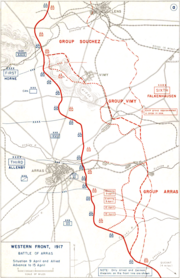Coordinates: 50°16′50.1594″N 2°46′58.7274″E / 50.280599833°N 2.782979833°E The Carrière Wellington is a museum in Arras, northern France. It is named after a former underground quarry which was part of a network of tunnels used by forces of the British Empire and Commonwealth during the First World War. Opened in March 2008, the museum commemorates the soldiers who built the tunnels and fought in the Battle of Arras in 1917.
History[]

Frontline at Arras immediately prior to the assault.
From the Middle Ages through to the 19th century, the chalk beds underneath Arras were extensively quarried to supply stone for the town's buildings. The quarries fell into disuse by the start of the 20th century. In 1916, during the First World War, the British forces controlling Arras decided to re-use the underground quarries to aid a planned offensive against the Germans, whose trenches ran through what are now the eastern suburbs of the town. The quarries were to be linked up so that they could be used both as shelters from the incessant German shelling and as a means of conveying troops to the front in secrecy and safety.
500 miners from the New Zealand Tunnelling Company, including Māori and Pacific Islanders, recruited from the gold and coal mining districts of the country, were brought in to dig 20 kilometres (12 mi) of tunnels. They worked alongside Royal Engineer tunnelling companies, made up by now of British coal miners and expert tunnellers who had built the London Underground. Many of them were "Bantams", soldiers of below average height who had been rejected from regular units because they did not meet the height requirements; others had been initially rejected as too old, but their specialist mining experience made them essential for the tunnelling operation.
The work was difficult and dangerous. In the New Zealand units alone, 41 tunnellers died and another 151 were injured during countermining operations against the Germans, whose own tunnellers sought to disrupt the Allied tunneling operations. The Arras tunnels linked the quarries to form a network that ran from the town centre, under no man's land, to a number of points just in front of the German front lines. The tunnel system could accommodate 20,000 men and were outfitted with running water, electric lights, kitchens, latrines, a light rail system and a fully equipped hospital. The tunnellers named the individual quarries after their home towns - Auckland, Wellington, Nelson, Blenheim, Christchurch and Dunedin for the New Zealanders, Glasgow, Edinburgh, Crewe and London for the Britons.
Thousands of soldiers were billeted in the tunnels for eight days prior to the start of the Arras offensive on 9 April 1917. At 05:30 that morning, exits were dynamited to enable the troops to storm the German trenches. The Germans were taken by surprise and were pushed back 11 km (6.8 mi). This counted as an extraordinary success by the standards of the time. However, the offensive soon bogged down and it was eventually called off after casualties reached 4,000 a day.
During World War II, the tunnels were re-opened to serve as air raid shelters. They were sealed again in 1945 and were largely forgotten until their rediscovery in 1990. Much of the network has now collapsed and most of the rest is extremely unsafe. With the sponsorship of the Arras town council, the regional council and the French state, one section around the Carrière Wellington was restored and converted into a museum at a cost of €4 million.
Museum[]
The Carrière Wellington museum consists of a visitor centre displaying historic artifacts and presenting the historical context of the Battle of Arras, including the work of the tunnellers and the military strategy that underlay the tunnels' construction. It was opened to the public on 1 March 2008.
The tunnels are accessed via a lift shaft that takes visitors approximately 22 m (70 ft) below ground to the galleries around the Wellington quarry. Visitors are taken on a guided tour along some 350 m of tunnels to see audio-visual presentations of various aspects of the campaign and the soldiers who built and stayed in the tunnels. At various places, graffiti and painted signs can be seen, along with relics of the troops such as cans of bully beef, helmets and bottles.
The museum is on the Rue Arthur Deletoile, a turning off the Avenue Fernand Lobbedez (D917), approximately 1 km south of the city centre (GPS navigation may lead an unwary visitor astray).
References[]
- Nicholls, Jonathon. Cheerful Sacrifice: The Battle of Arras 1917. Sheffield: Pen & Sword, 2005. ISBN 978-1-84415-326-8
- "Museum to shed light on diggers' world". New Zealand Herald, 15 February 2008
- "Great War tunnellers honoured". New Zealand Herald, 16 February 2008
- "French Museum showcases Tunneller's work". New Zealand Defence Force, 18 February 2008
- "Now you can visit the secret underground WW1 city built by British Tommies". Daily Mail, 3 March 2008
- "Inside the amazing cave city that housed 25,000 Allied troops under German noses in WWI". Daily Mail, 16 March 2008
External links[]
- Carrière Wellington (official website)
- - Information on the Carrière Wellington from La Voix du Nord (in French)
The original article can be found at Carrière Wellington and the edit history here.


